Key takeaways
- Minimalist dessert presentations emphasize simplicity and balance, allowing the dessert to be the star without distractions.
- This style encourages creativity through restraint, fostering appreciation for quality ingredients and precise techniques.
- Essential tools for achieving minimalist designs include an offset spatula, fine tweezers, and neutral-colored plates, all of which enhance visual elegance.
- Common mistakes include overcrowding the plate, neglecting balance, and inconsistency in execution, which can detract from the minimalist aesthetic.
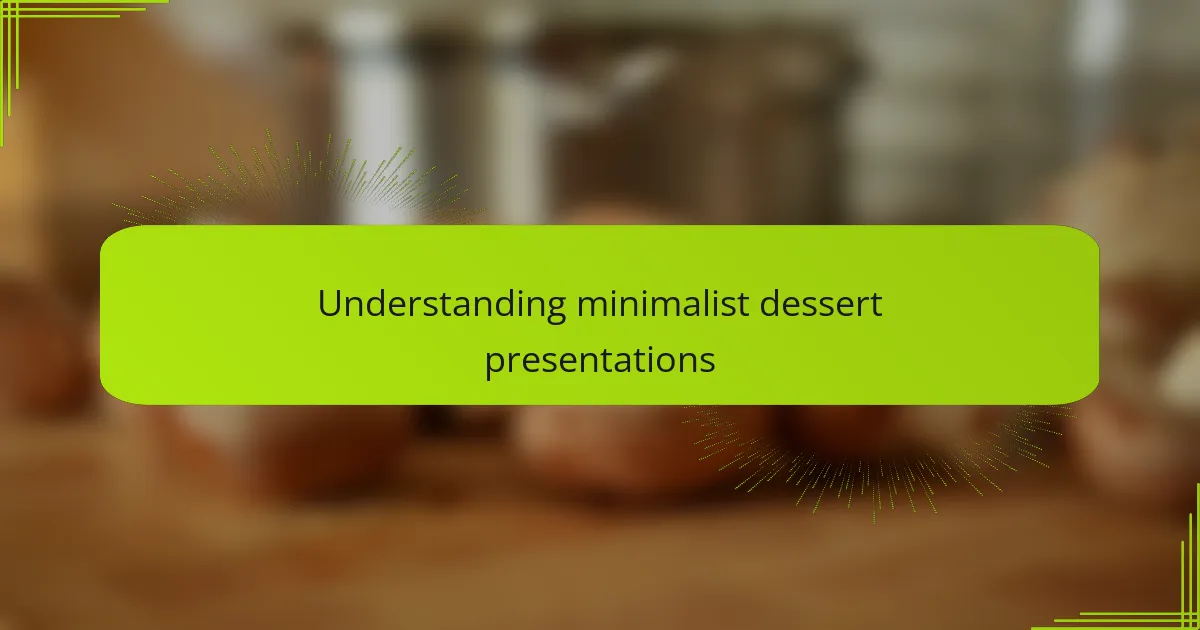
Understanding minimalist dessert presentations
Minimalist dessert presentations focus on simplicity and elegance, stripping away anything non-essential to highlight the dessert itself. I’ve noticed that when I plate a dessert minimally, it somehow feels more intentional and thoughtful, inviting you to truly savor each element. Isn’t it fascinating how less can sometimes say so much more on a plate?
For me, understanding this style means paying close attention to balance: a clean plate, a little artistic touch, and enough space for the dessert to breathe. Does the dessert still capture your eye when it’s surrounded by empty space? I find that emptiness actually creates a quiet spotlight, making each bite feel special.
Minimalism also encourages creativity in restraint, which can be surprisingly challenging but rewarding. When I challenge myself to keep things simple, I find new ways to express flavors and textures without overloading the senses. Have you ever been surprised by how a single garnish or a small drizzle can transform the entire experience?
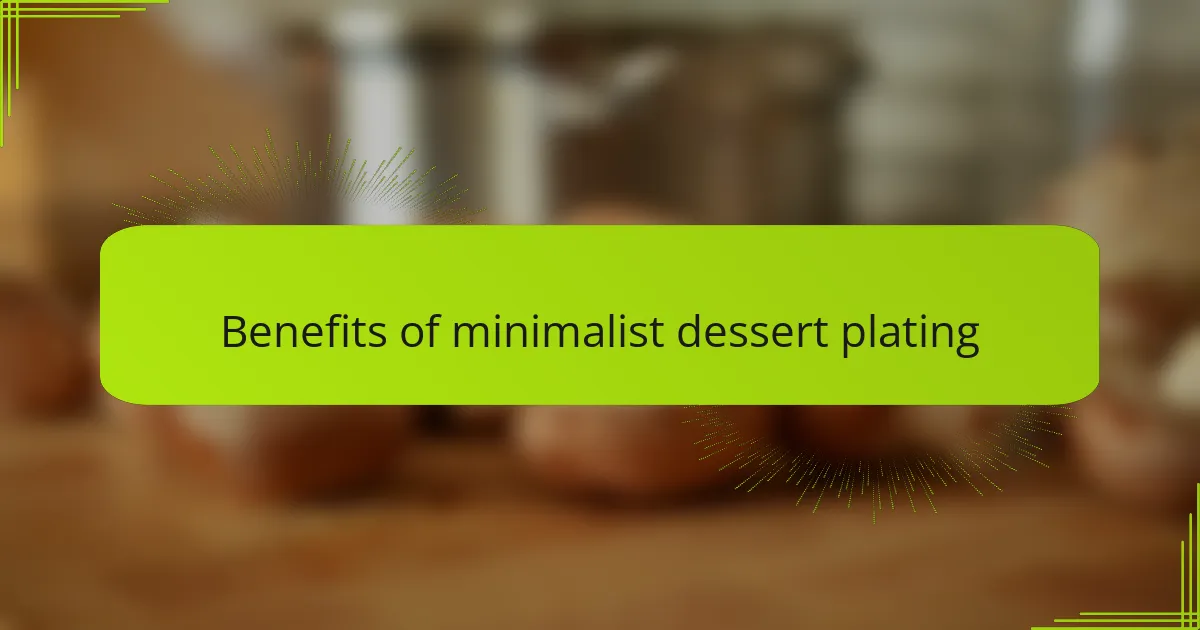
Benefits of minimalist dessert plating
One of the benefits I truly appreciate in minimalist dessert plating is how it lets the dessert itself shine without distraction. When I serve a clean, uncluttered plate, it feels like the flavors and textures become the real stars, inviting a deeper appreciation. Have you ever noticed how your attention sharpens when there’s nothing else competing for it?
Another advantage I’ve experienced is the sense of calm that minimalist plating brings to the dining experience. There’s something soothing about a simple presentation that puts me, and often my guests, at ease. It creates a moment of pause, almost like a silent invitation to slow down and enjoy that perfect bite.
Minimalist plating also makes it easier to highlight quality over quantity. I’ve found that focusing on a few well-crafted components encourages me to use better ingredients and refine techniques. Doesn’t it feel more rewarding to savor a thoughtfully plated dessert than to be overwhelmed by a crowded plate?
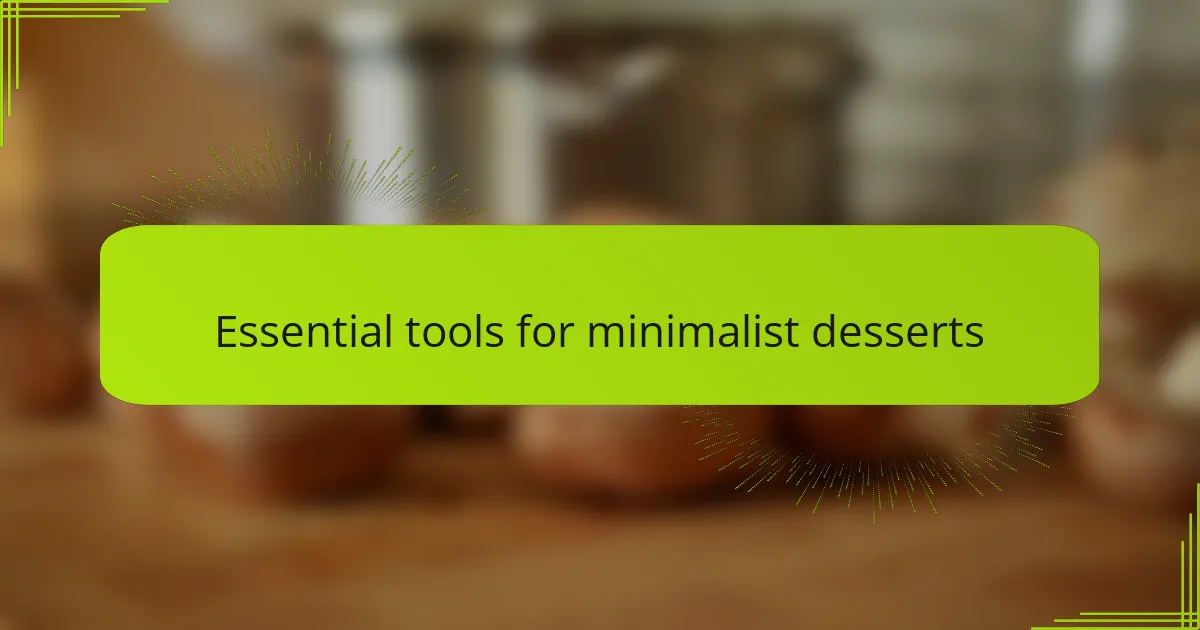
Essential tools for minimalist desserts
When I prepare minimalist desserts, I rely heavily on a few essential tools that help me achieve that clean, elegant look without fuss. A good offset spatula is indispensable for smoothing sauces or creams with precision, creating those sleek lines that catch the eye. Have you ever tried plating a dessert with just your fingers? It’s tricky to get that refined finish without the right tools.
Another must-have in my kitchen is a set of fine tweezers. They might sound like overkill for dessert plating, but they allow me to place tiny garnishes or delicate elements exactly where I want them, almost like an artist adding the final brushstrokes. It’s a small detail, but it makes a big difference in achieving that intentional, minimalist feel.
Finally, I can’t do without simple white plates or neutral-colored serving boards. I’ve found that the right backdrop is crucial—it frames the dessert like a piece of art without stealing the spotlight. Have you ever noticed how even the shape and size of your plate can change the whole mood of the presentation? For me, choosing the perfect plate is just as important as the dessert itself.
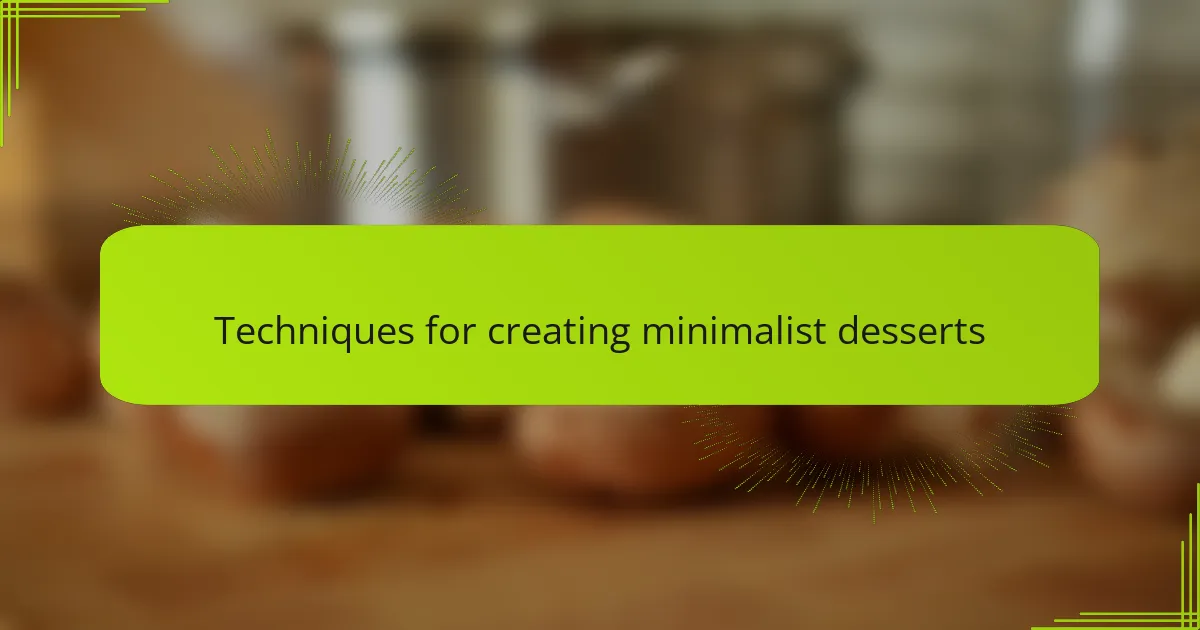
Techniques for creating minimalist desserts
One technique I swear by is mastering negative space on the plate. Leaving parts of the plate deliberately empty isn’t just about minimalism for minimalism’s sake; it actually frames the dessert, making it the undeniable focal point. Have you tried stepping back to appreciate how that empty space can create a sense of calm and draw your eye without distraction?
Another technique that’s worked wonders in my kitchen is limiting the color palette. Sticking to one or two harmonious hues keeps everything unified and elegant. I remember plating a lemon tart with just a dusting of powdered sugar and a single mint leaf—it was amazing how that tiny pop of green elevated the whole dish without crowding it.
Precision matters more than quantity in minimalist desserts. I often use small, deliberate strokes or dots of sauce rather than large pools to add interest without overwhelming. I’ve found that these restrained touches speak volumes about care and craftsmanship—don’t they make you appreciate the dessert even more?
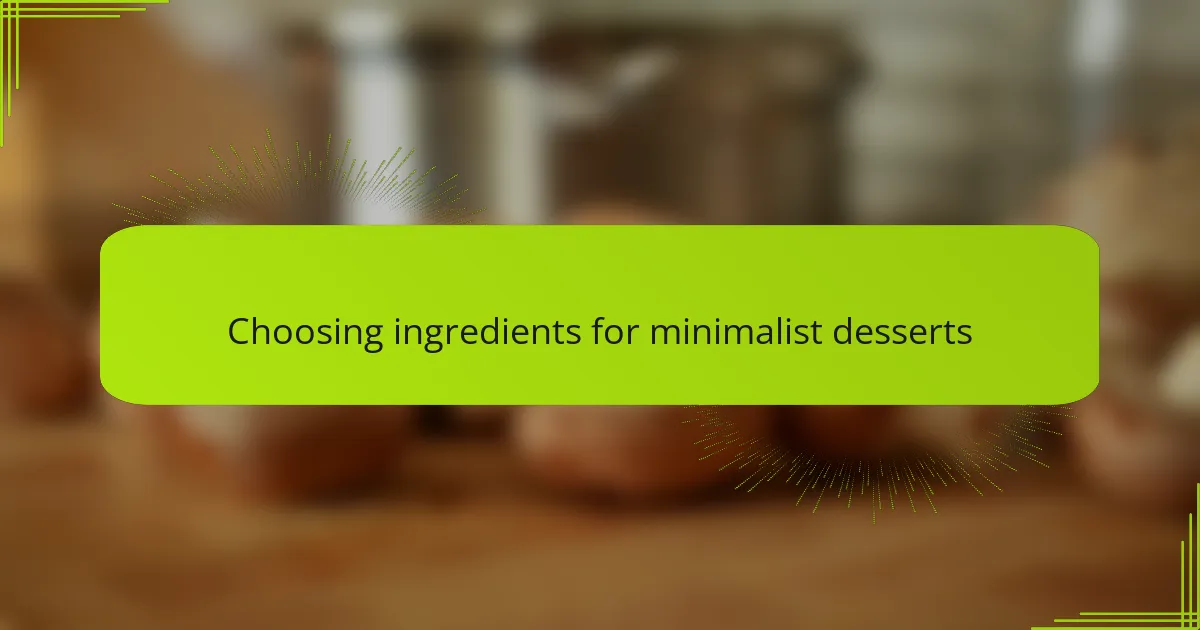
Choosing ingredients for minimalist desserts
Choosing ingredients for minimalist desserts means I have to be very selective—there’s no room for anything that doesn’t add clear value. I often pick flavors that are pure and distinct, like fresh berries or a high-quality chocolate, because each bite needs to tell a story without competing distractions. Have you noticed how a single, well-chosen ingredient can become the entire star of a minimalist plate?
Texture plays a huge role for me when selecting ingredients, too. I love combining something smooth with a bit of crunch or a subtle acidity to keep the dessert balanced and interesting, even when it’s visually simple. It’s surprising how just two or three contrasting textures can turn a minimal dessert into a memorable experience, don’t you think?
Another thing I consider is color and natural beauty of the ingredients themselves. Sometimes I’ll let a vibrant raspberry or a delicate edible flower do all the work because their color and shape add elegance without any extra fuss. Choosing ingredients that speak visually as well as taste-wise makes that minimalist presentation feel intentional and alive.
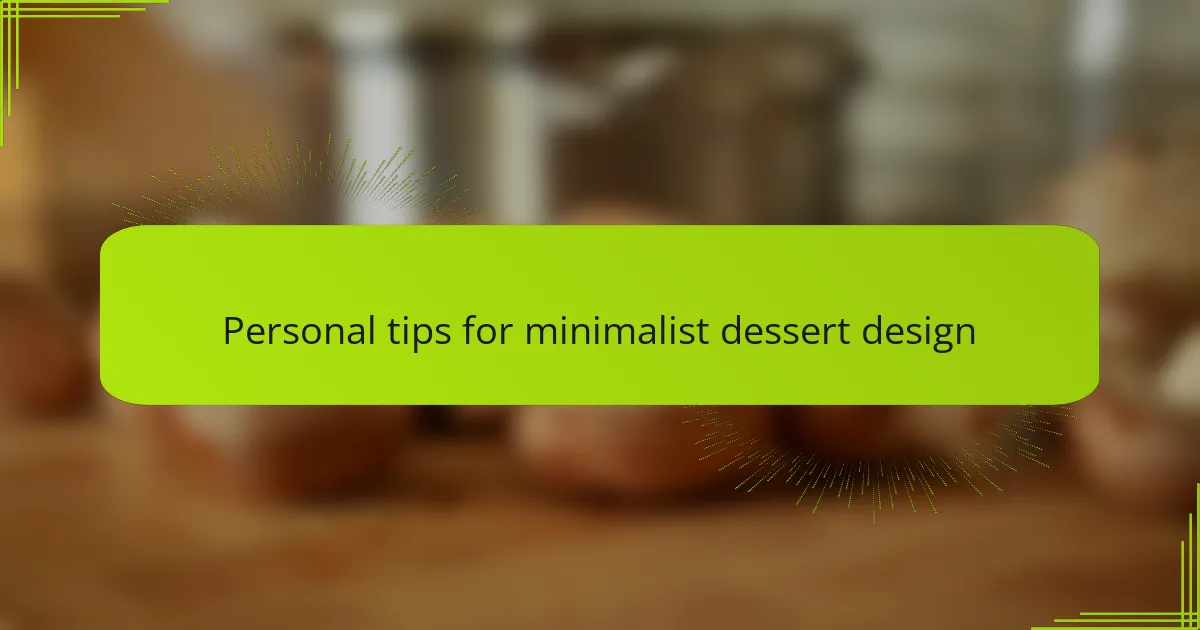
Personal tips for minimalist dessert design
When I design minimalist desserts, I always remind myself that restraint is a kind of freedom. It’s tempting to add more — a swirl here, a sprinkle there — but I’ve learned that true elegance comes from knowing when to stop. Have you ever felt that quiet satisfaction when a simple plate tells a full story without shouting?
I also focus on the placement of each element with care. For example, I like to position a single piece of fruit or a neat dollop of cream slightly off-center, creating a subtle asymmetry that catches the eye without clutter. It’s like composing a little visual poem on the plate, and it makes me appreciate the dessert in a new way.
Lastly, I never underestimate the power of bite-sized portions in minimalist design. Serving small, perfect portions might feel like less, but it actually amplifies anticipation and delight. Don’t you find that savoring a few thoughtful bites can be more memorable than overwhelming your palate? That’s the magic of minimalism for me.

Common mistakes in minimalist dessert presentations
One mistake I see often is overcrowding the plate. It’s tempting to add every garnish or sauce in sight, but that just defeats the purpose of minimalism. Have you ever looked at a dessert that felt busy and wondered where to focus? I’ve been there, and it made me realize that sometimes, less really is more.
Another common error is neglecting the importance of balance. Sometimes the dessert ends up too symmetrical or, on the flip side, completely random. I’ve found that a little asymmetry—like placing a sauce swipe just off-center—adds interest without chaos. Do you think that tiny imbalance might be what turns a simple plate into something artful?
Lastly, inconsistency in execution can ruin a minimalist presentation. One uneven dollop or a smudged plate suddenly pulls your attention away from the dessert itself. I remember serving a soufflé once with a barely noticeable fingerprint on the edge of the plate, and it haunted me the whole evening. Precision matters more than ever in minimalism, don’t you agree?




